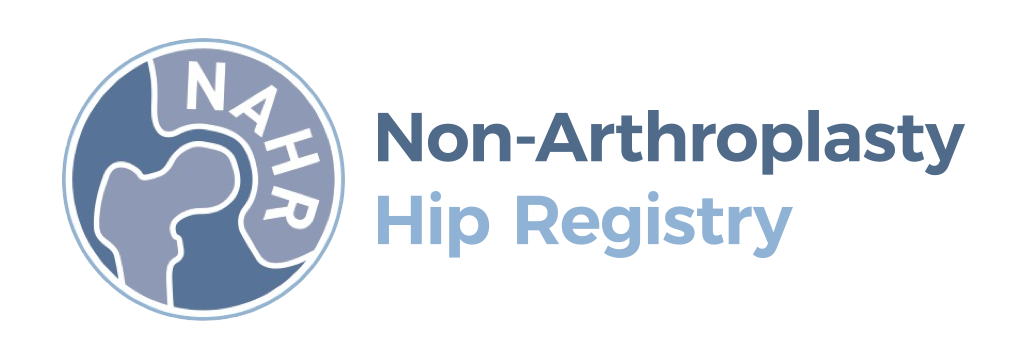The creation of a Non Arthroplasty Hip Registry (NAHR) was initiated by Mr John Timperley, Consultant Orthopaedic Surgeon at the Princess Elizabeth Orthopaedic Centre in Exeter and former President of the British Hip Society (BHS). He identified the rise in hip preservation surgery but noted, in contrast to joint replacement surgery, a lack of outcomes data outside of small scale published series. Given his interest and expertise in joint replacement registries from around the world, setting up a registry for non-hip replacement hip surgery seemed a logical thing to do. The motion to set up such a registry was unanimously supported by the Membership of the BHS at the Annual General Meeting in Torquay in March 2011 and the membership agreed that the BHS should fund the registry. The Registry went live in March at the 2012 BHS Annual Meeting in Manchester and was formally launched at the British Orthopaedic Association (BOA) Annual Congress in September 2012. NICE (National Institute for Clinical Excellence as it was then known) Interventional Procedure Guidance on Arthroscopic (IPG408) and Open (IPG403) Femoroacetabular Surgery for Hip Impingement Syndrome, published in September and July 2011 respectively, noted that clinicians should submit details to this national registry.
The User Group, initially chaired by Professor John Timperley and then Mr Marcus Bankes, developed during 2012 and 2013 and consisted of Mr Tony Andrade, Professor Tim Board, Professor Max Fehily, Mr Paul Gaston, and Mr Matt Wilson, with assistance from Mr Johan Witt and Professor Damian Griffin. A major streamlining exercise was undertaken in 2013 to improve surgeon compliance following meetings of interested parties at the BHS in Bristol in March and of the original NAHR User group at the BOA Congress in October. Whilst many arthroscopic and hip preservation surgeons were enthusiastic about the development of the NAHR in principal, many already had their own databases and were unsurprisingly unwilling to duplicate data entry. It was therefore decided that use of the data collection infrastructure which already existed for the National Joint Registry (NJR) in every hospital in England and Wales was essential for success to minimise surgeon involvement in data collection and capture cases.
In addition, a Minimum Data Set (MDS Version 1.0) was defined which included a pre-operative specific and general health measures, namely the iHOT-12 (International hip outcome tool – 12 question version) and the EQ-5D-5L (five dimensional measure of health-related quality of life, five level questionnaire developed by the EuroQol Group) respectively. Standardised paper data collection forms were redesigned to have a similar appearance to NJR forms to help with this process. Whilst it may seem outdated to develop a paper based system, availability of convenient hardware, particularly in clinic and theatre environments, varies immensely between hospitals. Whilst the advent of tablet devices is often hailed as the convenient solution to pre-operative data collection, maintenance and theft of these devices remains a major problem. Clearly the NAHR can be used entirely without paper forms for those institutions with durable electronic systems in place. Post-operative outcome data is electronic however, and patients are currently invited to complete outcome questionnaires six, twelve and twenty-four months after their operation with an email, linking them directly to the online forms.
Growth of the Registry continued and the MDS Version 1.1 was launched in February 2015 to include data fields for extent of pre-existing articular cartilage damage on both sides of the joint. Whilst there was little change in the way data was collected, there was increasing interest in non- joint replacement registries from other specialties from the BOA, lead at that time by the then President Colin Howie. This led to the formation of an umbrella organisation for these registries called TORUS (Trauma and Orthopaedic Registries Unifying Structure) in 2016 of which the NAHR was an original member. The formation of TORUS provided a shared operating framework that allowed consistency of practice and a central support function (to deal with issues such as data governance, contracting and managing registry suppliers, and resolving day-to-day issues) to reduce the burden on individual registries and introducing efficiencies. The importance of the NAHR being part of TORUS has been particularly highlighted recently in view of the introduction of General Data Protection Regulations (GDPR). Release of MDS Version 2.0 is planned for later in 2018 and will incorporate a new patient consent form. Elements of the new dataset include: labral grafting and details of the graft length and material; numbers of labral anchors used and there has been a refinement of pelvic osteotomy types recorded.
The importance of the NAHR to the BHS was demonstrated further in 2016 by a vote at the annual meeting in Norwich to add another elected post to the Executive of the BHS with direct responsibility for the Registry and to chair the NAHR Steering Committee. Mr Vikas Khanduja from Cambridge was elected unopposed to the role at the BHS meeting in London in March 2017. Paul Gaston and Max Fehily stepped down from their roles in 2015 and 2016 respectively, with their roles taken over by Mr Ajay Malviya, Mr Jon Conroy, and Mr Callum McBryde.
Clinicians can use the NAHR to collect and display comprehensive outcome data on all their patients using various outcome measures. The information sheet, consent form and minimum dataset version 1.1, which can be downloaded here, are designed to reflect the familiar format of the National Joint Registry (NJR) forms. They contain a basic mandatory dataset as well as an enhanced dataset for surgeons to record additional surgical findings.
